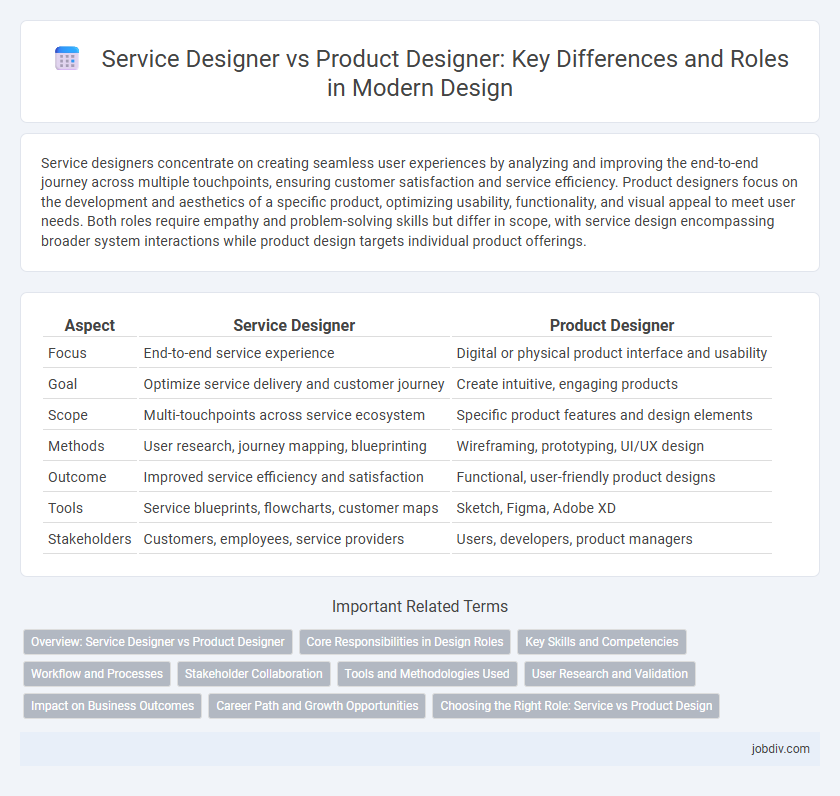Service designers concentrate on creating seamless user experiences by analyzing and improving the end-to-end journey across multiple touchpoints, ensuring customer satisfaction and service efficiency. Product designers focus on the development and aesthetics of a specific product, optimizing usability, functionality, and visual appeal to meet user needs. Both roles require empathy and problem-solving skills but differ in scope, with service design encompassing broader system interactions while product design targets individual product offerings.
Table of Comparison
| Aspect | Service Designer | Product Designer |
|---|---|---|
| Focus | End-to-end service experience | Digital or physical product interface and usability |
| Goal | Optimize service delivery and customer journey | Create intuitive, engaging products |
| Scope | Multi-touchpoints across service ecosystem | Specific product features and design elements |
| Methods | User research, journey mapping, blueprinting | Wireframing, prototyping, UI/UX design |
| Outcome | Improved service efficiency and satisfaction | Functional, user-friendly product designs |
| Tools | Service blueprints, flowcharts, customer maps | Sketch, Figma, Adobe XD |
| Stakeholders | Customers, employees, service providers | Users, developers, product managers |
Overview: Service Designer vs Product Designer
Service Designers focus on creating seamless end-to-end experiences by mapping customer journeys and identifying touchpoints across multiple channels. Product Designers specialize in developing and optimizing digital or physical products, emphasizing usability, functionality, and aesthetics. Both roles require collaboration with cross-functional teams but differ in scope, with Service Designers addressing holistic service ecosystems and Product Designers concentrating on individual product features.
Core Responsibilities in Design Roles
Service Designers focus on mapping user journeys and optimizing the overall customer experience across touchpoints by identifying pain points and streamlining service processes. Product Designers concentrate on creating and iterating tangible products, ensuring functionality, usability, and aesthetic appeal from concept to final design. Both roles require user-centered research, but Service Designers emphasize holistic service ecosystems, while Product Designers prioritize product features and interface design.
Key Skills and Competencies
Service Designers excel in mapping customer journeys, identifying pain points, and orchestrating seamless end-to-end experiences through cross-functional collaboration and systems thinking. Product Designers specialize in user interface design, usability testing, and prototyping to create intuitive, visually appealing digital products with a strong focus on user-centered design principles. Both roles require strong empathy, problem-solving abilities, and proficiency in design tools, but Service Designers emphasize strategic planning and service ecosystems while Product Designers prioritize interaction design and aesthetic execution.
Workflow and Processes
Service Designers prioritize mapping end-to-end customer journeys and orchestrating touchpoints across multiple channels, ensuring seamless interaction between service components. Product Designers concentrate on crafting user-centric interfaces and functionalities within a specific product, focusing on usability, aesthetics, and feature optimization. Workflow-wise, Service Designers employ systems thinking and stakeholder coordination, while Product Designers iterate through prototyping, user testing, and interface refinement.
Stakeholder Collaboration
Service Designers prioritize cross-functional stakeholder collaboration to map end-to-end customer journeys, ensuring seamless service delivery and organizational alignment. Product Designers focus on collaborating with engineering, marketing, and user experience teams to create user-centric digital products that meet business goals. Effective stakeholder engagement in both roles drives innovation and maximizes value creation throughout the design process.
Tools and Methodologies Used
Service Designers utilize tools like customer journey maps, service blueprints, and stakeholder maps to visualize user experiences and interactions across multiple touchpoints. Product Designers focus on wireframing, prototyping software such as Figma or Sketch, and usability testing to refine digital interfaces and product functionality. Both roles employ user research methods but diverge in approach, with Service Designers emphasizing systemic solutions and Product Designers prioritizing tangible product features.
User Research and Validation
Service Designers prioritize user research to map customer journeys and identify pain points across touchpoints, ensuring a holistic service experience. Product Designers focus on validating features through usability testing and iterative prototyping to optimize functionality and user satisfaction within the product interface. Both roles leverage qualitative and quantitative data but apply insights differently to enhance either the overall service or the specific product output.
Impact on Business Outcomes
Service Designers optimize user interactions across touchpoints to enhance customer satisfaction and operational efficiency, driving increased retention and reduced churn rates. Product Designers focus on creating intuitive, functional interfaces that boost user engagement and conversion rates, directly influencing revenue growth. Both roles synergize to align design strategies with business goals, maximizing overall market competitiveness and profitability.
Career Path and Growth Opportunities
Service Designers concentrate on optimizing user interactions and experience across multiple touchpoints, making their skills vital for sectors like healthcare, finance, and public services, which drives demand and diverse career opportunities. Product Designers focus on creating and improving physical or digital products with an emphasis on usability, aesthetics, and functionality, often leading to roles in tech companies, startups, and product management. Career growth for Service Designers often involves transitioning into strategic roles like UX strategy or service innovation, whereas Product Designers can advance into product leadership, design management, or entrepreneurship.
Choosing the Right Role: Service vs Product Design
Selecting between service design and product design hinges on the project's scope and user experience goals, with service design focusing on end-to-end customer journeys across multiple touchpoints, while product design centers on creating tangible or digital solutions with interactive elements. Service designers use systems thinking and stakeholder mapping to optimize service delivery and user satisfaction, whereas product designers prioritize usability, interface design, and feature development within a specific product. Understanding the business objectives and user needs helps determine whether to invest in service innovation strategies or product-centric design processes for maximum impact.
Service Designer vs Product Designer Infographic

 jobdiv.com
jobdiv.com